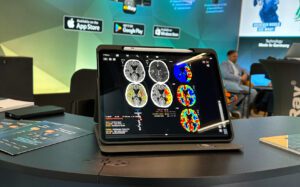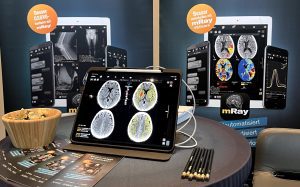The scientific journal "Der Radiologe" published an article about our concept for supraregional stroke care in its 61st issue. PD Dr. Dr. Karl Egger, Dr. Ingmar Gergel (CEO, mbits) and Hannah Syrek (Head of Research & Development, formerly mbits) were involved in this article.
The concept includes possibilities for networking all the players involved in the prehospital and in-hospital areas. In the treatment of strokes, imaging techniques are becoming increasingly relevant in therapy decisions.
For successful treatment of strokes, complex procedures must be coordinated between a wide variety of players in a very short time window, which usually presents hospitals with a major challenge. In addition to the established treatment method of thrombolysis, thrombectomy has also been clearly recommended since 2019, but is not fundamentally the best treatment method for all patients. In order to make the best possible treatment decision, the certified stroke units and stroke networks need defined processes and information technology tools in addition to their specialization in the latest treatment options. The integration of ambulance service, control center and emergency physician during the prehospital care of a patient contributes decisively to being able to perform a thrombectomy as quickly as possible on the right patient collective. The concept presented here aims to support this integration through digital networking. Here, mRay serves as a communication platform, whereby the modules available in mRay are always used partially.
In the preclinical area, mRay Stroke Triage will initially be used. The aim here is to optimize communication between the rescue service and the local stroke units and thrombectomy centers, thereby accelerating patient care. Once the patient arrives at the target hospital, all intra-hospital players are alerted via mRay and the image data generated in the course of the procedure is made available. Using the chat function of mRay, queries can be clarified quickly and the information is available to all players in a timely manner. The AI-based perfusion analysis is available to the treating physicians as a decision-making aid, which, like the other modules in mRay, can be easily integrated into the existing digital infrastructure.
Through the concept described in the article, prehospital and in-hospital processes can be digitally unified and optimized to provide better patient care and reduce subsequent socioeconomic costs.
The complete publication can be found here:
https://link.springer.com/article/10.1007/s00117-021-00876-6






